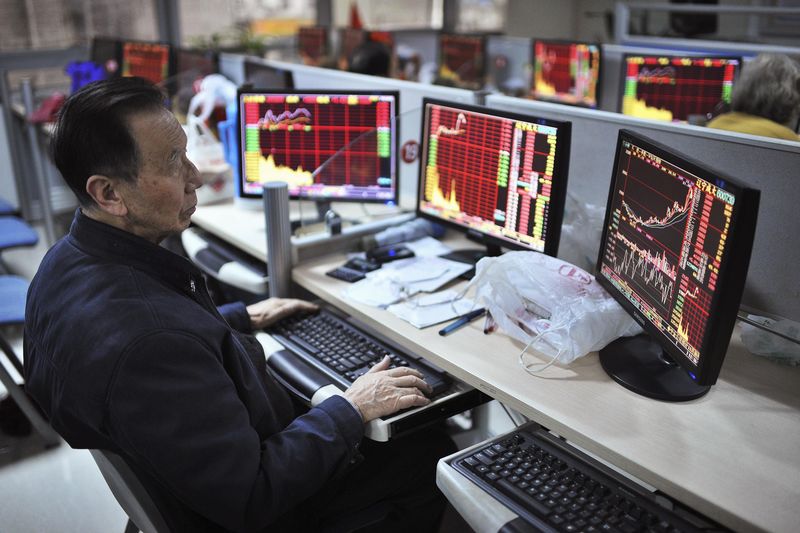Powell’s speech, Nvidia’s chips, Meta deal - what’s moving markets
* MSCI ACWI builds on biggest gains since 2008 financial
crisis
* Gold retain gains after big jump
* Dollar slides as funding squeeze eases a little
* European shares seen slightly higher
* Asian stock markets: https://tmsnrt.rs/2zpUAr4
By Hideyuki Sano
TOKYO, March 25 (Reuters) - Asian shares gained on Wednesday
in the wake of Wall Street's massive rebound as U.S. senators
and Trump administration officials reached an agreement on a
giant economic stimulus bill to alleviate the economic impact of
the coronavirus outbreak.
European benchmark stock futures STXEc1 rose more than 1%
in early trade but U.S. stock futures EScv1 were down 1% as
the news about the deal invited profit-taking after big gains
the previous day.
"No doubt it's a positive development that they've agreed...
But once it is approved the question is how it is implemented,"
said Jason Teh, chief investment officer at Vertium Asset
Management in Sydney.
"It's good the authorities are going to throw everything at
it. But if the virus is not controlled in the U.S., then they're
going to have to throw another trillion dollars."
MSCI's broadest index of Asia-Pacific shares outside Japan
.MIAPJ0000PUS gained 3.4% while Japan's Nikkei .N225 surged
6.9%.
"Japanese shares have been bolstered by aggressive buying
from the Bank of Japan and pension money this week. That has
prompted hedge funds to cover their short positions," said
Norihiro Fujito, chief investment strategist at Mitsubishi UFJ
Morgan Stanley Securities.
MSCI's gauge of stocks across the globe .MIWD00000PUS was
up 1.0%, having rallied 8.39% on Tuesday, the largest single-day
gain since the wild swings seen during the height of the global
financial crisis in October 2008.
On Wall Street, the Dow Jones Industrial Average .DJI
soared 11.37% on Tuesday, its biggest one-day percentage gain
since 1933.
Yet, much of the large gains in stock markets pale in
comparison with the brutal selloff of the past few weeks as
investors braced for a deep global recession due to the pandemic
and sweeping lockdowns in many countries.
The U.S. S&P500 .SPX is still down almost 28% from its
record peak hit just over a month ago.
"Many analysts have recently put out dire economic
forecasts, like annualised rate of 20% fall in U.S. GDP next
quarter. Europe and Japan should also see double-digit
contractions," said Nobuhiko Kuramochi, chief strategist at
Mizuho Securities.
"I suspect the outlooks have sunk in among market players
already and that the bear market has run about 80% of its course
for now."
STIMULUS
The U.S. stimulus deal, billed as a $2 trillion package, is
expected to include $500 billion in direct payments to people
and $500 billion in liquidity assistance. Investor fears about a sharp economic downturn also appear
to be easing somewhat after the U.S. Federal Reserve's offer of
unlimited bond-buying and programmes to buy corporate debt.
"Companies will see their revenues sink and indebted firms
will have trouble securing cash, so governments are making the
right responses," said Akira Takei, senior fund manager at Asset
Management One.
"The question is, while those responses are necessary in the
near term, what if this continues? You can't keep helping
companies that continue to make losses. The longer this drags
on, the more likely we will need to adjust to a new normal."
The biggest uncertainty is on how countries can slow the
pandemic and how quickly they can lift various curbs on economic
activity.
U.S. President Donald Trump pressed his case for a
re-opening of the U.S. economy by mid-April.
But that met immediate scepticism given the rise of
infections in the United States is now among the highest in the
world, with the total cases reaching more than 50,000 - doubling
in less than three days. In particular, its financial hub of New York City suffered
another quick and brutal rise in the number of infections to
around 15,000, raising worries about a shortage of hospital
beds. In the currency market, the dollar slipped as a greenback
liquidity crunch loosened slightly.
The euro traded at $1.0808 EUR= up 0.15% after four
straight days of gains.
The dollar stood flat at 111.16 yen JPY= , off a one-month
high of 111.715 touched the previous day.
Gold changed hands at $1,610.0 per ounce XAU= retaining
its gains of almost 5% on Tuesday, its biggest jump since 2008.
Oil prices bounced back as hopes for U.S. stimulus offset
fears of falling global demand.
India, the world's third largest oil consumer, ordered its
1.3 billion residents to stay home for three weeks, the latest
big fuel user to announce restrictions on social movement, which
have destroyed demand for gasoline and jet fuel worldwide.
The market remained pressured by a flood of supply after
Saudi Arabia started a price war earlier this month, a move that
dealt a crushing blow to markets already reeling from the
pandemic.
U.S crude futures CLc1 rose 4% to $24.96 per barrel. That
is up about $5.5, or about 26%, from their 18-year intraday low
of $19.46 touched on Friday. Still on the month, the market is
down 44%.
(Editing by Sam Holmes & Shri Navaratnam and Lincoln Feast.)
